Gerhardt 1967 Indy car-by-car histories
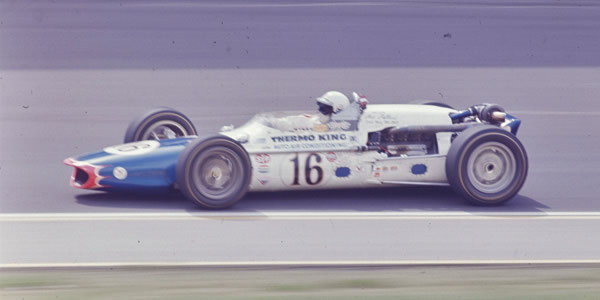
The house Gerhardt of Art Pollard at speed during the Indianapolis 500 in 1967. Part of the Dave Friedman collection. Licenced by The Henry Ford under Creative Commons licence Attribution-NonCommercial-NoDerivs 2.0 Generic. Original image has been cropped.
After the success of the 1966 cars, Gerhardt built a run of cars for 1967 featuring a full monocoque along Lotus 38 lines, replacing the bathtub monocoque of the earlier cars.
The 1967 Gerhardt was an evolution of the 1966 car, moving in the direction of the full "up-and-over" monocoque design used by Len Terry on his 1965 Lotus 38 design and then on his 1966 Eagle, so on most of the 1967 Gerhardts, the top section was a single piece reaching from the front suspension to behind the driver, rivetted in place. However, on one of the first cars to appear, a #16 Gerhardt house car to be raced by Art Pollard, this panel was split in two at the front of the cockpit and both parts were secured with Dzus fasteners, the only 1967 Gerhardt built in this way. This is referred to as 'Type A' below. The other 1967 Gerhardt to appear at the start of the season, for Gordon Johncock (#3 Gilmore), also had the panel split but the forward part was rivetted and only the cockpit sides held on with Dzus fasteners, called 'Type B' here. The car built for Wally Weir (#32 Cleaver-Brooks) followed the same fabrication as Johncock's car, and a third car was built to this pattern for the Federal Engineering team.
The rest of the 1967 production run all had one-piece rivetted top sections, called 'Type C' here. These were the cars for Caves Buick (#85 for Bill Cheesbourg and Al Miller), George Harm (#66 for Johnny Boyd), Federal Engineering (#10 for Bud Tingelstad) and Pete Salemi's Central Excavating team (#73 for Don Thomas); two cars for Racing Associates (#39 and #89); and also the #15 Gerhardt house car for Mel Kenyon, a second #16 Gerhardt house car for Pollard, a second #3 Gilmore car for Johncock, and finally a third #16 Gerhardt house car for Pollard after one of his cars was sold to Weinberger Homes and the other was destroyed in testing. Nine of these were ready for the Indy 500, making a total of 12 1967 Gerhardts built at that point. No press report has been found that itemised new Gerhardts for 1967 but later media said that 11 were built for the 1967 Indy 500. All of these 1967 cars, regardless of the style of their top bodywork, can be distinguished from 1966 Gerhardts by the number of fuel cell access panels visible on the side of the car. All 1966 cars had just one panel, on the engine pontoon, while all the 1967 cars had a second panel further forward, roughly level with the driver's seat.
Some issues are still being resolved. The #38 Federal Engineering car that Sonny Ates drove in practice at the Indy 500 looks like a '67 car even though it would make more sense for it to be the team's old 1966 car. Finally, Gordon Van Liew's #23 Vita-Fresh Orange Juice car for Ronnie Bucknum appears to have the shape of a 1967 car, but is otherwise 1966-style in construction, suggesting it was modified to match the outline of the 1967 cars.
Photographs are the best way to progress our knowledge, so if you have any pictures of these cars, or can add anything to our knowledge, please contact Allen Brown (allen@oldracingcars.com).
New for Art Pollard to drive in 1967 as the #16 Thermo King entry managed by Fred Gerhardt's son Don Gerhardt and with chief mechanic Phil Casey. This was the first of Pollard's three Gerhardts during 1967, and was fitted with a supercharger Offy engine. Pollard raced this at Phoenix in early April, at Langhorne in June, and probably at Mosport Park in early July. After Pollard's testing accident at Trenton later in July, photographs show that this car was sold to Weinberger Homes, fitted with a Ford V8, and was raced by Norm Brown as the team's #49 entry at Milwaukee, and by Mickey Shaw at Trenton in September, replacing an earlier Gerhardt-Ford that had been damaged at IRP. At the Indy 500 in 1968, Sammy Sessions drove the Weinberger Homes #49 Gerhardt turbo Offy in practice, but crashed prior to the start of qualifying, and the car could not be repaired for the race. Weinberger Homes did not run a Gerhardt again after this, focusing instead on the team's two Eagles. John Fugate worked for the Weinberger team from 1967 to 1970, and his recollection that that the Sessions Gerhardt was sent to be reskinned, and was still disassembled and unpainted when the team disbanded in 1970. Fugate was asked to sell the cars, and says that both this ex-Sessions car and a second ex-Gordon Johncock Gerhardt were sold to father and son racers in the US northwest who intended to use them in Super-Modified racing. Fugate later heard that one of them was killed in a racing accident and does not believe either Gerhardt was raced. Subsequent history unknown.
Driven by: Art Pollard, Norm Brown, Mickey Shaw and Sammy Sessions. First race: Phoenix International Raceway (R1), 9 Apr 1967. Total of 7 recorded races.
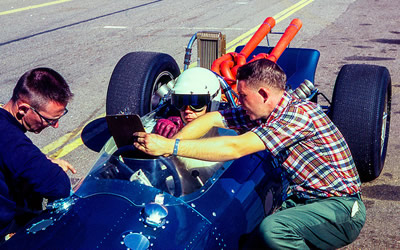
Gordon Johncock testing his new 1966/67 Gerhardt at Phoenix prior to the 1967 season. Note the riveted section as far as the front of the cockpit, then a cockpit surround held by Dzus fasteners. Copyright Richard Deming 2017. Used with permission.
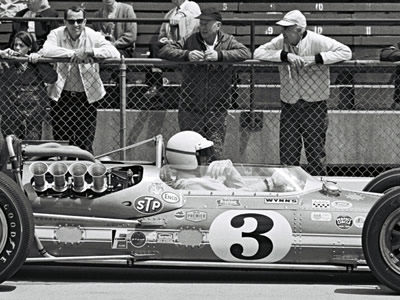
Gordon Johncock in his #3 Gilmour Broadcasting Gerhardt at the 1967 Indy 500. The Dzus fasteners are still visible in this picture. Part of the Dave Friedman collection. Licenced by The Henry Ford under Creative Commons licence Attribution-NonCommercial-NoDerivs 2.0 Generic. Original image has been cropped.
Gordon Johncock set up a new team for 1967 with backing from Jim Gilmore of Gilmore Broadcasting and raced a pair of new Gerhardts with Ford quad-cam engines that season. His first Gerhardt differed from later Gerhardts by having Dzus-fastened sides, and this car can be seen in photographs of Johncock testing at Phoenix prior to the first race of the season. He used his second fully-rivetted car in the race at Phoenix and is thought to have raced it at Trenton as well, before giving this Dzus-fastened car its race debut at the Indy 500. He used the Dzus-fastened car again at Milwaukee a week later, where he won, at Langhorne in June, and at Mosport in early July. He may also have used it at Indianapolis Raceway Park later in July, but then used the fully-rivetted car at Langhorne in July, Mont Tremblant, Milwaukee in August, and Hanford in October. The history of this Dzus-fastened car is unknown after July 1967. It may be relevant that Johncock bought a 1966 Gerhardt from Leader Cards after the Dzus-fastened car's last appearance with him to act as a backup, suggesting that this 1967 car was no longer available to him, perhaps as a result of an accident during testing.
Driven by: Gordon Johncock. First race: Indianapolis Motor Speedway (R3), 31 May 1967. Total of 6 recorded races.
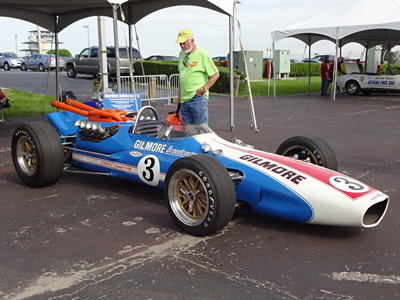
Jack Murray's ex-Gordon Johncock Gerhardt at Indianapolis in 2016. Copyright Jack Murray 2016. Used with permission.
New to Gordon Johncock's new Gilmore-backed team for 1967 as a second car with fully-rivetted bodywork, following the early car with Dzus-fastened sides that Johncock had used in testing prior to the opening race. Johncock used this fully-rivetted second car for the race at Phoenix in April, and is thought to have used at at Trenton. After using the Dzus-fastened at the Indy 500 and at Milwaukee in June, photographs show he used the fully-rivetted car at Langhorne in July, where he took pole position in a new record for a one-mile closed course of 125.913 mph, at Mont-Tremblant and Milwaukee in August, at Hanford, and at Riverside. For 1968, Johncock acquired another new Gerhardt, but one of his 1967 cars is likely to have been his early-season car and may have become his short-track car after the Indy 500. Photographs suggest that this car is the one he used at Stardust in March, and Phoenix in April. History then unknown but it may have become a show car for Gilmore Broadcasting and remained in the Gilmore stable after Gilmore and Johncock split at the end of the 1970 season. This is likely to be the ex-Johncock Indy car that Jim Gilmore had in the recreation room of his home on Gull Lake, near Kalamazoo, MI, in 1985. The car was still owned by Gilmore at the time of his death in December 2000. Bought from the estate by Phil Gumpert (Noblesville, IN) in 2001. Sold to Jack Murray (San Diego, CA) in September 2014. On display at the Historic Indycar Exhibition in May 2016.
Driven by: Gordon Johncock. First race: Phoenix International Raceway (R1), 9 Apr 1967. Total of 11 recorded races.
Dan Levine's Federal Engineering bought two new Gerhardts for 1967, the first of which had the Dzus-fastened sides only seen on a handful of that year's production. It was fitted with a supercharged Offy engine and is thought to be the car raced by Bud Tingelstad at Trenton in April. It was then the team's #38 entry for Al Smith at the Indy 500, was then raced by Tingelstad as his #10 at Milwaukee a week later and then by Smith and Sam Session as the #38 entry at three later races. It was fitted with a turbo Offy for 1968 and was used by Tingelstad at about four races, by Sonny Ates as the team's #31 entry at the Indy 500, and by Ates and Carl Williams at four races at the end of the season. At the car's last-known appearance, Phoenix in November 1968, Ates spun in Turn 1 and was rammed by Johnny Rutherford's Eagle, damaging both cars.
Driven by: Bud Tingelstad, Al Smith, Sammy Sessions, Sonny Ates and Carl Williams. First race: Trenton Speedway (R2), 23 Apr 1967. Total of 13 recorded races.
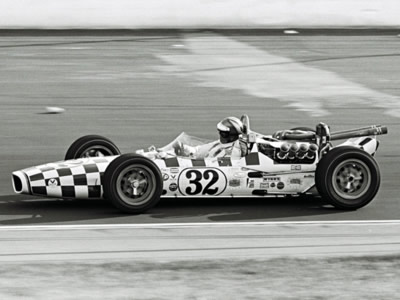
Al Miller raced Walter Weir #32 Gerhardt-Ford at the 1967 Indy 500. Part of the Dave Friedman collection. Licenced by The Henry Ford under Creative Commons licence Attribution-NonCommercial-NoDerivs 2.0 Generic. Original image has been cropped.
A new car in 1967 for Walter Weir (Webster Groves, MO) and fitted with a DOHC Ford. Entered at the Indy 500 for F1 driver Lorenzo Bandini but when the Italian died after a crash at the Monaco GP, the Gerhardt was driven in the 500 by Al Miller. Weir returned to the Indy 500 with the car in 1968 and 1969 but it did not qualify for either race. Weir died in a motor accident in February 1970 and the Gerhardt was bought five months later by Dudley Higginson (St Louis, MO). He entered for the 1971 Indy 500 as the #30 St Louis Special, by which time it had been reconfigured into a "wedge" and fitted with a turbo Offy. Bill Puterbaugh got the drive but he put it in the wall in practice and it was "extensively damaged. It must have been repaired, as Higginson entered it again in 1972 but it did not arrive. Chuck Haines (St Louis, MO) later found it in Missouri and sold it to Charles S. Hayes (Elkhart, Indiana) in the early 1990s. Bought from Hayes by Jimmy Brokensha (Nth Vancouver, BC, Canada) and Pete Schomer, and restored by them to 1967 spec. Bought by Mike Canepa (Grants Pass, OR) in the spring of 2000 for vintage racing but not used and advertised in 2014 before being sold to Jack Murray (San Diego, CA). On display at the Historic Indycar Exhibitions in 2015, 2016 and 2019. The car was consigned by Murray to the Mecum auction at Monterey in August 2019.
Driven by: Al Miller, Bill Cheesbourg, Arnie Knepper and Bill Puterbaugh. First race: Indianapolis Motor Speedway (R3), 31 May 1967. Only one recorded race.
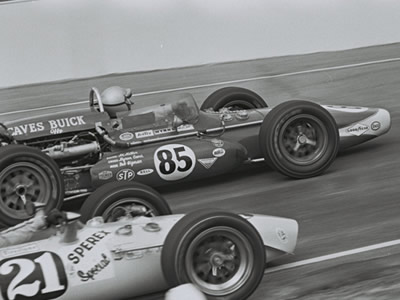
The #85 Caves Buick Gerhardt-Offy turbo at Riverside at the end of the 1967 season. Photographs at Hanford and at Trenton show an identical car. Part of the Dave Friedman collection. Licenced by The Henry Ford under Creative Commons licence Attribution-NonCommercial-NoDerivs 2.0 Generic. Original image has been cropped.
Having run a 1966 Gerhardt through the 1966 season, the Caves Buick team acquired a new 1967 model in time for that year's Indy 500. It was raced by Al Miller as the #85 entry for the rest of the season, but it is possible the team's older 1966 car was used at some tracks. At the 1968 Indy 500, the team's main #14 Quaker State Special Gerhardt-Offy was their usual 1967 car, but a "twin" had been acquired as the backup #73 entry. Chuck Hulse drove Caves' #14 entry in the pre-Indy 500 races, and then ran the #73 car in practice at the Speedway before leaving the team on 18 May. Bob Hurt took over the drive but crashed the car heavily on the morning of final qualifying, resulting in significant rear damage to the car. Hurt suffered broken vertabrae in his neck and spinal cord injuries which left him paralysed from the neck down. Whether the car was repaired or replaced is uncertain, but Sammy Sessions drove Caves' #14 entry for the rest of 1968 and it is assumed the team used the new "twin" thereafter.
Driven by: Al Miller, Bill Cheesbourg, Chuck Hulse, Bob Hurt and Sammy Sessions. First race: Langhorne International Motor Speedway (R5), 18 Jun 1967. Total of 11 recorded races.
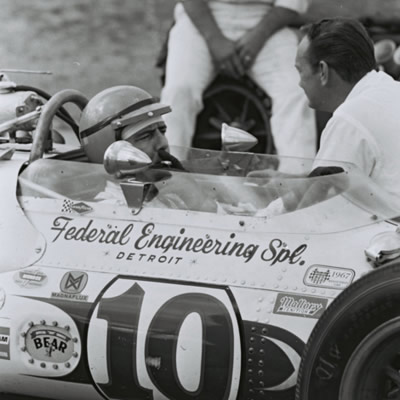
Bud Tingelstad in the #10 Federal Engineering Gerhardt at Indianapolis in 1967. Part of the Dave Friedman collection. Licenced by The Henry Ford under Creative Commons licence Attribution-NonCommercial-NoDerivs 2.0 Generic. Original image has been cropped.
Dan Levine's Federal Engineering acquired two new Gerhardts for the 1967 season, one with Dzus-fastened sides which was fitted with a supercharged Offy engine, and this fully-rivetted car which was fitted with a Ford engine. This was the #10 Federal Engineering entry for Bud Tingelstad at the 1967 Indy 500 and was his car at most races that season. It was fitted with a turbo Offy for 1968, and was again Tingelstad car at the Indy 500 and most races. It is thought to have been Bobby John's #35 Federal Engineering Special at Indy in 1969, a car that had outboard front springs. It continued in use alongside the team's newer 1968-type Gerhardt in 1970 and also had a handful of outings in 1971, being driven by Eldon Rasmussen at the last two races of the season. History then unknown until a car with outboard springs seen fully restored to Tingelstad's #10 livery at Indianapolis in May 2011 when it was driven by Parnelli Jones. Prepared then by Greg Elliff of G.E. Autosports (Avon, IN). Also driven at Indy in 2012 when it was owned by Jeff Urwin. Also seen at the the Historic Indycar Exhibitions in 2013 and 2019.
Driven by: Bud Tingelstad, Arnie Knepper, Bobby Johns, Bill Puterbaugh, Al Loquasto, Sammy Sessions, Jim Malloy, Bob Harkey, Greg Weld and Eldon Rasmussen. First race: Indianapolis Motor Speedway (R3), 31 May 1967. Total of 32 recorded races.
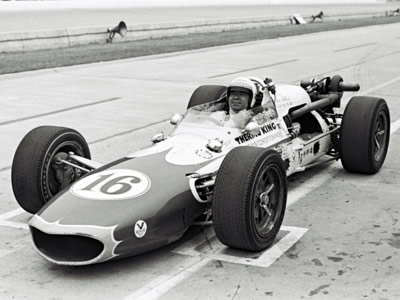
Art Pollard in Don Gerhardt's #16 Thermo King entry at the 1967 Indy 500. Part of the Dave Friedman collection. Licenced by The Henry Ford under Creative Commons licence Attribution-NonCommercial-NoDerivs 2.0 Generic. Original image has been cropped.
Art Pollard had two new Gerhardts for the 1967 season, one with a supercharged Offy engine which was used on short tracks, and a turbo Offy car used at the Indy 500. There were small but significant differences between the two cars. His turbo Offy was first raced as the #16 Thermo King entry at the Indy 500 and was then Pollard's mount at Milwaukee on 4 June where it was damaged. He then used his short track supercharged Offy car at Langhorne. He was using his Indy 500 car at a test session at Trenton Speedway on 19 July 1967, when he crashed heavily. Pollard suffered a broken leg and serious burns, and would be out of racing for three months. The Gerhardt is believed to have been destroyed.
Driven by: Art Pollard. First race: Indianapolis Motor Speedway (R3), 31 May 1967. Total of 2 recorded races.
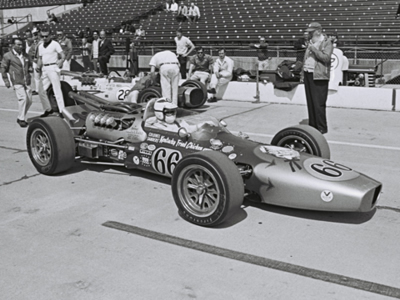
Johnny Boyd in George Harm's #66 KFC Gerhardt in practice for at the 1967 Indy 500. Part of the Dave Friedman collection. Licenced by The Henry Ford under Creative Commons licence Attribution-NonCommercial-NoDerivs 2.0 Generic. Original image has been cropped.
New to George R. Harm, a promiment Fresno businessman, fitted with a Ford V8 and entered for the 1967 Indy 500 as the #66 KFC car for Johnny Boyd, also Fresno born and bred. The car was built larger than other Gerhardt's to fit Boyd's broader frame. When the entry was announced on 8 February 1967, the car was described as being new and joint chief mechanics were listed as veteran Gerhardt mechanic Fred DeOrian and Roy Wiley, another Fresno resident and an experienced Indy mechanic who regularly worked with Boyd. Despite the hand-picked team of Fresnans, Boyd did not qualify at Indy and failed to qualify again at Milwaukee the following weekend. He then retired from racing and later sued George Harm for "not providing a racing car in good and proper condition". The future of the Gerhardt is unknown but given the close Fresno connections back to the Gerhardt factory, it may well have returned to the factory to be reconditioned and sold.
Driven by: Johnny Boyd. First appearance: Indianapolis Motor Speedway (R3), 31 May 1967.
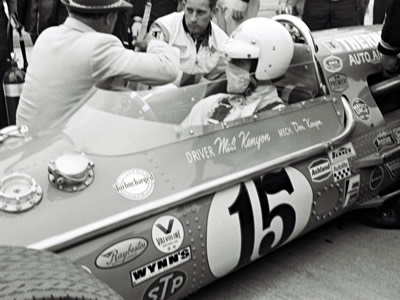
Mel Kenyon awaits the start of the 1967 Indy 500 in his #15 Thermo-King Gerhardt. Part of the Dave Friedman collection. Licenced by The Henry Ford under Creative Commons licence Attribution-NonCommercial-NoDerivs 2.0 Generic. Original image has been cropped.
Mel Kenyon's Gerhardt at the 1967 Indy 500 is identified by Clymer as a new car and Kenyon's 1968 500 car is identified by that year's Clymer Yearbook as being the same car. It is presumably the #15 Gerhardt that Kenyon drives through the rest of 1967 and in early 1968. Crashed heavily in practice at Milwaukee in June 1968, and later interviews with Kenyon imply this car was not repaired. Kenyon had a new 1968 Gerhardt later in the season.
Driven by: Mel Kenyon. First race: Indianapolis Motor Speedway (R3), 31 May 1967. Total of 11 recorded races.
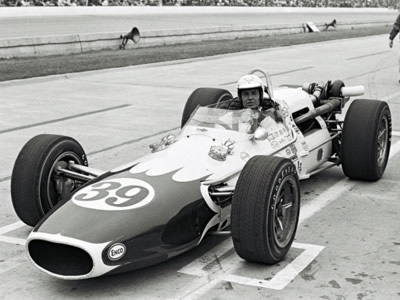
Bobby Grim qualified this #39 Gerhardt for Racing Associates at the 1967 Indy 500. Part of the Dave Friedman collection. Licenced by The Henry Ford under Creative Commons licence Attribution-NonCommercial-NoDerivs 2.0 Generic. Original image has been cropped.
Herb Porter and Ebb Rose of Racing Associates entered a #39 Gerhardt with Offy turbo engine for Bobby Grim at the 1967 Indy 500 which is identified by Clymer as a new car. The team also had a very similar car entered at #89 and it was that car that Grim raced at the next two events. He returned to the #39 car for three races later in the season. After 1967, the Racing Associates team withdraws and the various one-off Racing Associates entries at later Indy 500s never arrived at the track but presumably allowed space for Porter's engine-building business. The Gerhardt is unknown after the end of 1967.
Driven by: Bobby Grim. First race: Indianapolis Motor Speedway (R3), 31 May 1967. Total of 4 recorded races.
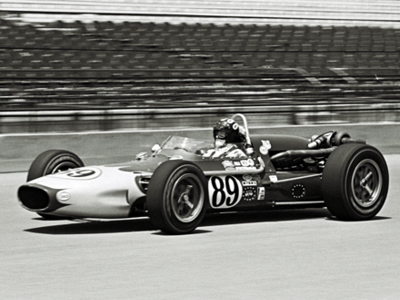
Ebb Rose's entered a #89 Racing Associates Gerhardt in practice for the 1967 Indy 500. Part of the Dave Friedman collection. Licenced by The Henry Ford under Creative Commons licence Attribution-NonCommercial-NoDerivs 2.0 Generic. Original image has been cropped.
Herb Porter and Ebb Rose of Racing Associates entered a #89 Gerhardt with Offy turbo engine for Rose at the 1967 Indy 500. Rose did not qualify the #89 but it was raced at the next two events by teammate Bobby Grim. Unknown after July 1967.
Driven by: Ebb Rose and Bobby Grim. First race: Milwaukee Mile (R4), 4 Jun 1967. Only one recorded race.
Pete Salemi's Central Excavating team entered Don Thomas in a #73 Gerhardt-Offy at the Indy 500 in 1967, and photographs suggest that it was a new 1967 car. Thomas got through his Rookie test but then crashed the car on Wednesday 17 May. Bruce Jacobi drove the #73 car at Milwaukee in early June, then Thomas was back in the seat at Langhorne a fortnight later, but failed to qualify. He crashed again in practice at IRP in July, at which point Bob Hurt took over the drive, qualifying for the race. Jacobi drove it at the next two races but at Mont-Tremblant on 6 August, put the car into a bank, severely damaging it. The team's entry changed from #73 to #81 after this accident, suggesting they were using a different car, but photographs show that it was the same car. Later used by the team at Milwaukee and Trenton in the fall of 1967, then at four races in 1968, up to and including Ronnie Duman's fatal accident at Milwaukee in June 1968. This car was very heavily damaged in the accident and it seems highly unlikely that it would have been used again. Salemi acquired an updated 1966 Gerhardt from Gordon Van Liew's team, and completed the season with that.
Driven by: Don Thomas, Bruce Jacobi, Bob Hurt, Ronnie Duman, Arnie Knepper, Bob Harkey and Dempsey Wilson. First race: Milwaukee Mile (R4), 4 Jun 1967. Total of 9 recorded races.
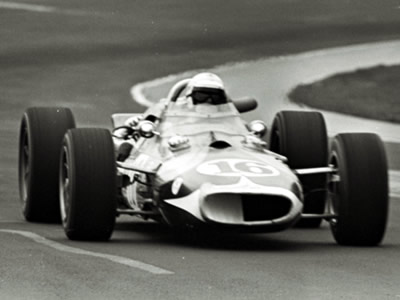
Bob Veith's #16 Thermo King Gerhardt at the 1968 Indy 500. Part of the Dave Friedman collection. Licenced by The Henry Ford under Creative Commons licence Attribution-NonCommercial-NoDerivs 2.0 Generic. Original image has been cropped.
After Art Pollard's fiery crash while testing his Indy 500 car at Trenton in July 1967, a new turbo Offy car would have been needed for his return at Hanford in October. Pollard set pole position in this car at the brand new 1.5-mile D-shaped Hanford oval. Pollard retained this car in early 1968 (now as his #11 car) and was then Bob Veith's #16 Thermo King Gerhardt at the 1968 Indy 500 which was identified by Clymer as having been built in the summer of 1967. It was raced by the team's new driver Gary Bettenhausen at Milwaukee in August, and was presumably the short track #11 car at other races in 1968. It is presumably also the #16 Thermo King Gerhardt that appeared for Rutherford at Langhorne and for Snider (and Andretti) at Phoenix in November. Unknown after November 1968.
Driven by: George Snider, Art Pollard, Bob Veith, Johnny Rutherford, Gary Bettenhausen and Mario Andretti. First race: Hanford Motor Speedway (R19), 22 Oct 1967. Total of 14 recorded races.
1968
Several of the 1967 Gerhardts go missing by the end of the year: George Harm's Ford V8 car with its enlarged cockpit for Johnny Boyd, and both the Herb Porter/Racing Associates Offy-powered cars. Also, we do not know how Gordon Johncock's two Ford-engined cars were used in 1968. One of these, apparently the later one, remained with Johncock for the first few races of the season, but he then acquired two new 1968 Gerhardts, and the old 1967 cars may well have been sold. One is said to have gone to Myron Caves' team, which is plausible, but it must have been rebuilt for an Offy turbo installation. The Caves team did acquire a second 1967 Gerhardt for 1968, but photographs suggest that it was one of the Herb Porter/Racing Associates cars. The Gerhardt team retained one 1967 Gerhardt for use on road courses, but its identity is not yet resolved.
One other unexplained Gerhardt that appeared in 1968, a new car for Ken Brenn's team, has now been identified as a 1966 car.
During the 1968 season, the Gerhardt team used a separate car for road courses. Photographs indicate this was a 1967 Gerhardt, and a former Offy car. However, few photographs have been found of this car so far, and it is possible the team started the season using an older 1966 car for this purpose. The team's road course car would have been raced as the #11 Thermo King Auto Air Conditioning entry by Art Pollard at Stardust International in March, and then by Gary Bettenhausen at Mosport Park in June, at Continental Divide in July, at Indianapolis Raceway Park two weeks later, at Mont-Tremblant in August, and at Riverside in December. Nothing more is known about this car.
Driven by: Art Pollard and Gary Bettenhausen. First race: Stardust International (R2), 31 Mar 1968. Total of 9 recorded races.
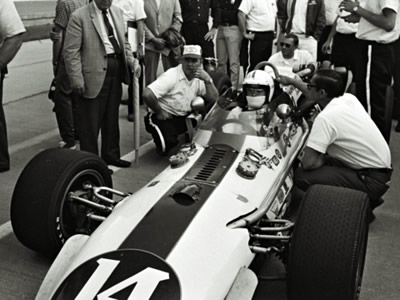
The #14 Caves Buick Gerhardt-Offy turbo is readied for the 1969 Indy 500. Part of the Dave Friedman collection. Licenced by The Henry Ford under Creative Commons licence Attribution-NonCommercial-NoDerivs 2.0 Generic. Original image has been cropped.
The Caves Buick team acquired a backup car in time for the 1968 Indy 500 that was described as a "twin" to their 1967 car. After Bob Hurt crashed the primary car during practice, it is assumed that Sammy Sessions drove this "twin" thereafter as the #14 Caves Buick entry. In 1969, Jigger Sirois took over the Caves drive and his car was described as a 1967 Gerhardt and also as "last year's car" at the start of the season, but his car had outboard springs at the Indy 500, a 1968/69 modification, whereas both cars at the 1968 Indy 500 had had inboard springs. Sirois was called off by Caves during his qualifying run when he would, with hindsight, have taken pole. Bob Harkey and Jim McElreath took over the drive later in 1969. At Trenton in July 1969, the team had a brand new Gerhardt wedge which implies the early 1969 car was their 1968 car carried over. A photo of the #14 car at Indy in 1969 (Hungness p37) matches the team's backup #53 car at Indy in 1970. The car was last seen at Langhorne in June 1970 when it was very badly damaged by fire after it was crashed by Sammy Sessions. Caves, who was then very unwell, said he doubted he'd repair it as it was "getting too bruised to be competitive".
Driven by: Sammy Sessions, Jigger Sirois, Bob Harkey, Jim McElreath and Arnie Knepper. First race: Milwaukee Mile (R6), 9 Jun 1968. Total of 19 recorded races.
1969 and 1970
Another Gerhardt appeared later in 1969, for Max Dudley, and evidence currently suggests that it was built new for him. In 1970, another Gerhardt was built up for Darrell Dockery by his crew chief Larry Burton, using an unfinished monocoque acquired from Fred Gerhardt. Both were previously thought to be built on 1968 Gerhardts but photographs of both these cars show that they did not have the circular access panel on the side of the tub roughly level with the drivers' knees, and should therefore be regarded as 1967 'Type C' Gerhardts.
Max Dudley (Auburn, WA) raced a Chevrolet-powered Gerhardt in Indy racing from 1969 to 1971, and then reappeared briefly in 1974. The car replaced a 1965 Halibrand Shrike that Dudley had raced in 1968 and early 1969, and which he sold to Bob Cavanaugh. Cavanagh's recollection is that the Gerhardt was new. (Curiously, Dudley was reported by Autoweek to be running the Halibrand Shrike at the Seattle USAC Road Racing Championship race in Sep 1971.) The only other time he appeared was at Trenton in early 1974 with a Gerhardt-Chev again. The Gerhardt was then unknown until seen fully restored at the 2009 Seattle Historic Races when it was said to be a 1968 Gerhardt. Also at the Classic Car Races at Sears Point in June 2011. Believed to be the car owned by William Watkins. At the Victory Lane Historic Champ/Indy Car Showcase in June 2012.
Driven by: Max Dudley. First race: Continental Divide (R7), 6 Jul 1969. Total of 16 recorded races.
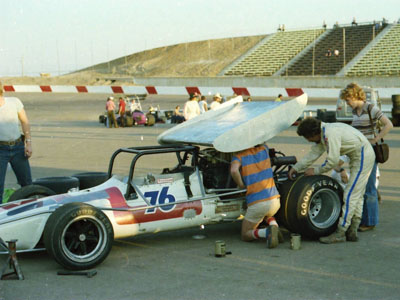
Lloyd Beard and his family crew prepare the Gerhardt for a race at Mesa Marin in 1979. Copyright Beard family 2019. Used with permission.
Acquired from Fred Gerhardt by Darrell Dockery (Phoenix, AZ) as an unfinished monocoque, and built up by Dockery's chief mechanic Larry Burton at the Gerhardt race shop in Fresno, CA, using parts that were "lying around". Burton recalled that the tub had been intended for a turbo Offy engine, so Burton modified it to fit a Chevrolet V8 engine. However, photographs of the car in later life indicate that it was intended for a Ford engine, and is similar in construction to a 1967 Gerhardt. Like the 1969 Gerhardts, it had outboard front suspension. Dockery appeared in the #62 Gerhardt-Chev on a number of occasions in 1970, generally failing to qualify or going out with an oil leak. The 1970 Indy 500 entry list gives the engine as a 312 ci V8, but Burton recalls fitting a Ford quad cam engine during practice. The car was put to one side until 1976, when it was acquired by veteran Super-Modified class driver Lloyd Beard (Los Banos, CA), a distant cousin of Dockery, and his sponsor Dave Buchanen. He first raced the Gerhardt in May 1976 in Open Competition racing at Clovis Speedway in northern California. Despite the car's unreliability, Beard led an Open Competition race at San Jose Speedway in August 1977, and led again at San Jose two weeks later. Beard was killed in a sprint car accident at Calistoga on 27 October 1979, and the Gerhardt was sold off to Bob Beck. Subsequent history unknown.
Driven by: Darrell Dockery and Lloyd Beard. First race: Phoenix International Raceway (R1), 28 Mar 1970. Total of 14 recorded races.
Acknowledgements
Given how little was known of the histories of individual Gerhardt cars when this research project began in 2009, the progress made is remarkable. Much of the early work was conducted by Michael Ferner and Allen Brown, but credit for the recent discoveries must go to Simmo Iskül, through his forensic analysis of the cars using old photographs.
These histories were last updated on .